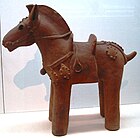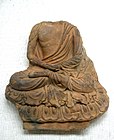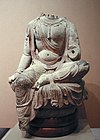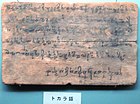Tokyo National Museum
東京国立博物館 | |
 The Honkan (Main Gallery) | |
 Interactive fullscreen map | |
| Established | 1872 (Yushima Seido Exhibition) 1873 (permanent display) 1882 (present location) 2007 (present administration) |
|---|---|
| Location | Ueno, Taitō, Tokyo, Japan |
| Coordinates | 35°43′8″N 139°46′35″E / 35.71889°N 139.77639°E |
| Type | Art museum |
| Collection size | 110,000 |
| Visitors | 2,180,000 (2017)[1] |
| Public transit access |
|
| Website | tnm.jp |
The Tokyo National Museum (東京国立博物館, Tōkyō Kokuritsu Hakubutsukan) or TNM is an
The facilities consist of the
The Tokyo National Museum is one of four museums operated by the
Names
The museum went through several name changes. The original 1872 exhibition was known as the "Museum of the Ministry of Education".[5] The compound in Uchiyamashita-chō was initially known simply as "the Museum" (Hakubutsukan)[6] before becoming the "Sixth Bureau of the Home Ministry", after which it was again known as the Museum and then the "Museum of the Museum Bureau".[6] It was renamed the Imperial Museum in 1888, reflecting its change of ownership of the imperial household.[7] As other museums opened, this changed to the more specific Tokyo Imperial Household Museum in 1900.[5] Following the government reforms imposed after World War II, it was renamed the "National Museum" in 1947[5] and the "Tokyo National Museum" in 2001.[5] The museum is also sometimes known as the "Ueno Museum".[8]
History
Yushima Seido Exhibition
The Tokyo National Museum is the oldest national museum in Japan.
-
The oldYushima Seido(1830)
-
The maleshachi of the Nagoya Castleat the exhibition. Shosai's ukiyo-e print.
-
Directors of the exposition, before the golden shachi in the Taiseiden courtyard (1872)
Uchiyamashita museum
While the Vienna World Fair was going on, the locally-held objects were organized by the Exposition Bureau into a temporary display at a compound in Uchiyamashita-chō (now 1-Chome in
-
An engraving of the Art Gallery for the first National Industrial Exhibition (1877)
-
Hiroshige III's ukiyo-e triptych showing its interior (1877)
-
Guide map to the 1881 Second National Industrial Exhibition
-
Hiroshige III's ukiyo-e triptych of the second NIE (1881), showing the original Honkan
Ueno museum
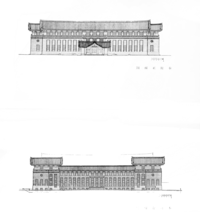

A ceremony attended by
Upon the marriage of
The present Honkan was opened to the public in 1938,
The museum saw attendance begin to fall after 1925;[17] it was closed in 1945 during the final phases of the Second World War.[citation needed] It was placed under the Ministry of Education in 1947,[5] the Independent Administrative Institution National Museum in 2001 (merging its administration with the Kyoto, Nara, and—in 2005—Kyushu National Museums),[20] and the Independent Administrative Institution National Institutes for Cultural Heritage in 2007 (merging the IAINM's administration with the national institutes for cultural preservation in Tokyo and Nara).[21]
From October 18, 2022 to December 11, the Tokyo National Museum celebrated its 150 year anniversary by displaying all of its 89 national treasures in a single exhibition for the first time.[22]
Facilities
Honkan (Japanese Gallery)




The Honkan (本館, Main or Japanese Gallery)
The Honkan is located on the former site of the main hall of the
It was replaced by
The rooms are ordered beginning with the SE corner of the second floor, passing clockwise around the second and first floor, and ending with the SW corner of the first floor.[23]
| Second Floor | First Floor | ||
|---|---|---|---|
| Room | Title | Room | Title |
| 1 | The Dawn of Japanese Art and Rise of Buddhism | 11 | Japanese Sculpture |
Yayoi, Kofun
| |||
| 2 | National Treasure Gallery | 12 | Lacquerware |
| Various periods | |||
| 3 | Zen & Ink Painting
|
13 | Metalwork and Ceramics |
Muromachi
| |||
| 4 | The Art of Tea Ceremony | 14 | Thematic Exhibition |
| Various periods | |||
| 5 | Attire of the Military Elite | 15 | Records of History |
| Heian, Edo | |||
| 6 | Attire of the Military Elite | 16 | Ryukyu
|
| Heian, Edo | |||
| 7 | Folding Screens and Sliding Door Paintings
|
17 | Conservation and Restoration |
| Various periods | |||
| 8 | The Arts of Daily Life and Developments in Painting and Calligraphy | 18 | Modern Art |
Azuchi-Momoyama, Edo
| |||
| 9 | Noh and Kabuki | 19 | Education Space |
| Various periods | |||
| 10 | Edo Period
|
20 | Giftshop |
| Edo | |||
The basement holds another educational space.[23]
-
A MiddleJōmonvessel (3000–2000 BCE)
-
Kokin Wakashū, Heian period, 10th century
-
Samantabhadra, Heian period, 12th century
-
Cintamani in flame type, 12th–13th century
-
A gilt-wood statue of Vairocana Buddha, Heian period, 11th-12th century
-
Twelve Heavenly Generals, Kamakura period, 13th century
-
Okanehira, Heian period, 12th century
-
Ō-yoroi, Edo period, 16th century
-
Kakiemon, Edo period, 17th century
-
Noh mask from the Konparu school, Edo period, 18th century
-
Kosode, Edo period, 18th century
-
Eagle by Suzuki Chokichi, 1892
Heiseikan

The Heiseikan (平成館,
The Heiseikan was first opened in 1999.
The Japanese Archaeology Gallery introduces the use of
-
The earliest polished stone tools in the world. Pre-Jōmon (Japanese Paleolithic) period, 30,000 BCE.
-
IncipientJōmon pottery (radiocarbon dated to 12500 ±350 BP)[25]
-
A FinalJōmonstatuette (1000–400 BCE)
-
Horse chariots during the Kofun period. Detail of bronze mirror (5th–6th century). Eta-Funayama Tumulus, Kumamoto.
-
Iron helmet and armour with gilt bronze decoration, Kofun period, 5th century
-
The Buddha, Asuka period, 7th century
-
Temple tiles fromNara, 7th century
-
Vine and grape scrolls from Nara, 7th century
Toyokan (Asian Gallery)

The Tōyōkan (東洋館,
The Toyokan was designed by Yoshirō Taniguchi, opened in 1968, refurbished in the early 2010s, and reopened in January 2013.[26] It is three stories tall but employs its basement and a spiral arrangement of mezzanines and stairs to spread its collection over six floors.[26]
| Floor | Room | Name |
|---|---|---|
| B1 | 11 | Khmer Sculpture |
| 12 | Gilt Bronze Statues from Southeast Asia Archaeology of India and Southeast Asia Southeast Asian Ceramics | |
| 13 | Asian Indian Miniature Paintings
Ethnic Cultures of Asia | |
| 1 | 1 | Chinese Buddhist Sculpture |
| 2 | 2 | Oasis2 Education Space |
| 3 | Egypt
| |
| 3 | 4 | The Advent of Chinese Civilization
|
| 5 | Chinese Textiles
| |
| 6 | Oasis6 Education Space | |
| 4 | 7 | Stone Relief Carvings of China
|
| 8 | Chinese Literati
| |
| 5 | 9 | Decorative Art of the Qing Dynasty
|
| 10 | Polished Art of the Joseon Dynasty
|
-
One of the first representations of theBuddha, 1st–2nd century CE, Gandharafrom Pakistan
-
Seated Buddha, Gandhara, 1st–2nd century CE
-
Bacchanalian scene, representing the harvest of wine grapes, Greco-Buddhist art of Gandhara, 1st-2nd century CE
-
Drinking scene, Greek drinking cups, Greek dress. Greco-Buddhist art of Gandhara. 3rd century CE.
-
Greek scroll supported by Indian Yaksas, Amaravati Stupa, 3rd century
-
Northern Wei Buddha Maitreya, 443
-
The Toyokan's collection of Chinese bronzeware
Horyuji Homotsukan (Gallery of Horyuji Treasures)
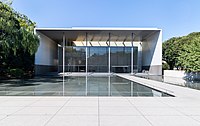
The Hōryū-ji Hōmotsukan (法隆寺宝物館, Gallery of Horyuji Treasures) is a two-story building housing the museum's
The 319 items were given to the Imperial Household by the temple in 1878, then placed at the National Museum for safekeeping and preservation.The building was designed by Yoshio Taniguchi[27] and opened in 1999.[5]
| Floor | Room | Name |
|---|---|---|
| 1 | 1 | Banner for the Kanjo Ceremony
|
| 2 | Gilt Bronze Repoussé Buddhist Images
| |
| 3 | Gigaku Masks
| |
| 2 | 4 | Wooden and Lacquer Works |
| 5 | Metalwork | |
| 6 | Textiles
|
A mezzanine between the two floors holds a Reference Room[27] with a digital archive of the treasures, allowing visitors to view the entire collection with explanations in Japanese, Korean, Chinese, English, French, and German.[citation needed] There is a restaurant on the first floor.[27]
Hyokeikan

The Hyōkeikan (表慶館, Congratulatory Gallery)
Kuroda Kinenkan (Kuroda Memorial Hall)

The Kuroda Memorial Hall (黒田記念館, Kuroda Kinenkan) holds a collection of works by the important Western-style (yōga) artist Kuroda Seiki. Its collection presently comprises 126 oil paintings and 170 drawings, as well as sketchbooks, letters, &c.[30][31] Located northwest of the main museum compound, it has free admission and separate hours of operation (9:30 AM–5:00 PM, with the last admission at 4:30).[32]
Designed by
The exhibition on the second floor consists of 4 rooms: the Kuroda Memorial Room, the Reading Room, the Audiovisual Room, and the Collection Highlights Gallery. There is also a cafe on the first and second floors.[32]
-
Self-portrait in a Turkish Hat (1889)
-
Girl with Red Hair (1892)
-
Portrait of a Woman (1898)
-
Hong Kong (1900)
-
Jar of Flowers (1912)
Shiryokan (Research and Information Center)
The Shiryōkan (資料館, Research and Information Center) holds books, magazines, images, and other documents relating to history, archaeology, and the fine and applied arts in Japan, Asia, and the Middle East.[34]
The Research and Information Center was opened in 1984.[34] The floor open to the public includes two reading rooms, an exhibition area, and counters for requesting items held in the archives on the other floors.[34] Free access is available without admission to the rest of the museum through the compound's west gate.
Operating budget issues
The Japanese government's cultural budget is consistently low: in 2017, the cultural budget was one-fifth that of France and one-third that of South Korea.[35] The Tokyo National Museum's annual budget is a paltry ¥2 billion,[36] which is one-seventeenth that of the Louvre, one-fifth that of the British Museum, and one-third that of the National Museum of Korea.[35] By 2023, the museum was struggling to delay repairs to cultural assets and pay utility bills for its facilities due to rising electricity and other costs. The museum has asked the government to increase its budget, but the request has not been granted. The museum's director often complains about its plight in the media.[36]
Access
- JR East and Tokyo Metro)
- JK JY Uguisudani Station (with JR East)
- KS Keisei Ueno Station (with Keisei Electric Railway)
- C Nezu Station (with Tokyo Metro)
See also
- Lists of National Treasures and Horyuji Treasures at the Tokyo National Museum
- Kuromon ("Black Gate"), one of two surviving feudal main gates in Tokyo
- Kyoto, Kyushu, and Nara National Museums
- Japanese art
- Greco-Buddhist art
- Silk Road
- Machida Hisanari
- Wuzhun Shifan
- List of largest art museums
- List of National Treasures of Japan
Notes
- ^ * Tokyo National Museum
* Kyoto National Museum
* Nara National Museum
* Kyushu National Museum - ^ Counting like 110,000 or 89 is not the number of objects. For example, 1 set of 12 Buddha statues is counted as 1.
- ^ * National Museum of Modern Art, Tokyo
* National Crafts Museum (Japan)
* National Museum of Modern Art, Kyoto
* National Museum of Western Art
* National Museum of Art, Osaka
* The National Art Center, Tokyo
* National Film Archive of Japan - ^ * National Museum of Japanese History
* National Museum of Ethnology (Japan) - ^ Although sometimes called the oldest pottery in the world,[25] the Japanese finds have been superseded by newer discoveries in China with the objects found in Xianren Cave, Jiangxi, in 2012 the oldest known as of 2019.
References
Citations
- ^ 2017 TEA-AECOM Museum Index, published May 2018
- ^ a b "Frequently asked questions about the Tokyo National Museum". Tokyo National Museum. Archived from the original on 28 April 2023. Retrieved 29 April 2023.
- ^ 文化財指定等の件数 (in Japanese). Agency for Cultural Affairs. 5 April 2023. Archived from the original on 28 April 2023. Retrieved 29 April 2023.
- ^ 国立文化財機構概要 2022 (PDF) (in Japanese). National Institutes for Cultural Heritage. p. 6. Archived from the original (PDF) on 14 March 2023. Retrieved 29 April 2023.
- ^ a b c d e f g h i j k l m n o p "Outline of the Independent Administrative Institutions National Museum 2005" (PDF). IAI National Museum Secretariat. 2005. p. 9. Archived from the original (PDF) on 2009-02-26.
- ^ a b c d e f TNM (2019), Yamashitamon-nai Museum: The Museum under the Home Ministry.
- ^ a b c d e f g h i j k TNM (2019), Ueno Museum: The Original Honkan.
- ^ Tseng (2004), p. 474.
- ^ Nussbaum, Louis-Frédéric (2005), "Museums", Japan Encyclopedia, pp. 671–673.
- ^ a b c TNM (2019), Yushima Seido Exposition.
- ^ TNM (2019), The Jinshin Survey: Research of Cultural Properties.
- ^ a b c d e TNM (2019), The World's Fair in Viena: The Origin of the Japanese Modern Museum.
- ^ TNM (2019), The National Industrial Exhibition: The Museum and the Encouragement of Industries.
- ^ Sutherland & al. (1995), p. 6.
- ^ Tseng (2004), p. 475.
- ^ TNM (2019), Shojakukan and Asakusa Bunko: Foundation of the Museum Library.
- ^ a b c d TNM (2019), The Great Kanto Earthquake and the Museum: From Taisho to Showa Era.
- ^ Tseng (2004), p. 472.
- ^ a b c d e f TNM (2019), Construction of the New Honkan: The Museum during World War II.
- ^ Kyushu National Museum (PDF), Independent Administrative Institution National Museum, 2005, p. 16, archived from the original (PDF) on 2009-08-16.
- ^ Outline (PDF), Independent Administrative Institution National Institutes for Cultural Heritage, 2007, p. 5.
- The Mainichi. 26 October 2022.
- ^ a b c d TNM (2019), Honkan.
- ^ a b TNM (2019), Heiseikan Floor Map.
- ^ a b Imamura (1996), 44–46.
- ^ a b c TNM (2019), Toyokan Floor Map.
- ^ a b c d TNM (2019), The Gallery of Horyuji Treasures Floor Map.
- ^ a b c TNM (2019), Hyokeikan Floor Map
- ^ Guide Map (Map). Tokyo National Museum. 2015.
- ^ a b 東京文化財研究所黒田記念館本館 [Main Building, Kuroda Memorial Hall, Tokyo Research Institute for Cultural Properties] (in Japanese). Agency for Cultural Affairs. Archived from the original on December 23, 2019. Retrieved 10 September 2015.
- ^ a b "Kuroda Memorial Hall". Tokyo National Museum. Retrieved 10 September 2015.
- ^ a b c d TNM (2019), Kuroda Memorial Hall Floor Map.
- Independent Administrative Institution National Research Institute for Cultural Properties, Tokyo. Retrieved 10 September 2015.
- ^ a b c TNM (2019), Research and Information Center Floor Map.
- ^ a b 海外とくらべて少ない人数と予算……日本の美術館を取り巻く現実 (in Japanese). Kodansha. 15 July 2023. Archived from the original on 15 March 2024. Retrieved 15 March 2024.
- ^ Bungeishunju. 9 January 2023. Archived from the originalon 29 February 2024. Retrieved 15 March 2024.
References
- Imamura, Keiji (1996), The Prehistory of Japan and Its Position in East Asia, London: University College London Press, ISBN 9780824818524.
- Sutherland, Mary; et al. (1995), National Parks of Japan, Kodansha, ISBN 4-7700-1971-8.
- Tseng, Alice Y. (December 2004), "Styling Japan: The Case of Josiah Conder and the Museum at Ueno, Tokyo", Journal of the Society of Architectural Historians, vol. 63, Society of Architectural Historians, University of California Press, pp. 472–497, JSTOR 4128015.
External links
- Official site, Tokyo National Museum (in English)
- Sundberg, Steve (2019), "Ueno Park Museums, c. 1910", Old Tokyo, including images of the National Museum through the 20th century.
- Virtual tour of the Tokyo National Museum provided by Google Arts & Culture
 Media related to Tokyo National Museum at Wikimedia Commons
Media related to Tokyo National Museum at Wikimedia Commons
























![Incipient Jōmon pottery (radiocarbon dated to 12500 ±350 BP)[25]](http://upload.wikimedia.org/wikipedia/commons/thumb/9/9f/JomonPottery.JPG/128px-JomonPottery.JPG)



